by Akash Sriram
(Reuters) – Uber Applied sciences Inc (NYSE: ) and Chinese language automaker BYD (SZ: ) introduced a multi-year partnership on Wednesday aimed toward delivering 100,000 new electrical automobiles to the worldwide ride-hailing platform.
The businesses stated the partnership will present drivers with accessible pricing and financing for BYD electrical automobiles on the Uber platform, beginning in Europe and Latin America and increasing to markets within the Center East, Canada, Australia and New Zealand. .
Excessive sticker costs and rising borrowing prices have been boundaries to EV adoption over the previous two years, inflicting demand for such automobiles to develop slower than anticipated.
Escalating considerations about local weather change and the pressing want to cut back greenhouse fuel emissions have pushed the electrification of the worldwide transportation trade.
Uber and BYD will present drivers with reductions on automobile upkeep, charging, financing and leasing based mostly on market circumstances to assist the transition to electrical automobiles.
“When Uber drivers change to electrical automobiles, they will obtain as much as 4 occasions the emissions profit in comparison with common drivers just because they’re on the highway longer,” Uber CEO Dara Khosrowshahi stated in a press release.
The 2 firms added that they may work collectively to combine BYD’s automobiles and autonomous driving expertise into the ride-hailing platform.
BYD’s U.S. rival Tesla Inc (NASDAQ: BYD) will launch its robotaxi product in October because it seems to be to remodel itself after gross sales of electrical automobiles fell within the first two quarters of this yr.

BYD overtook Tesla final yr to develop into the world’s largest electrical automotive maker, though the Musk-led EV maker has since regained the highest spot.
Uber stated in January it was working with Tesla to advertise electrical automobile use amongst drivers in america, with the objective of reaching zero emissions in U.S. and Canadian cities by 2030.
